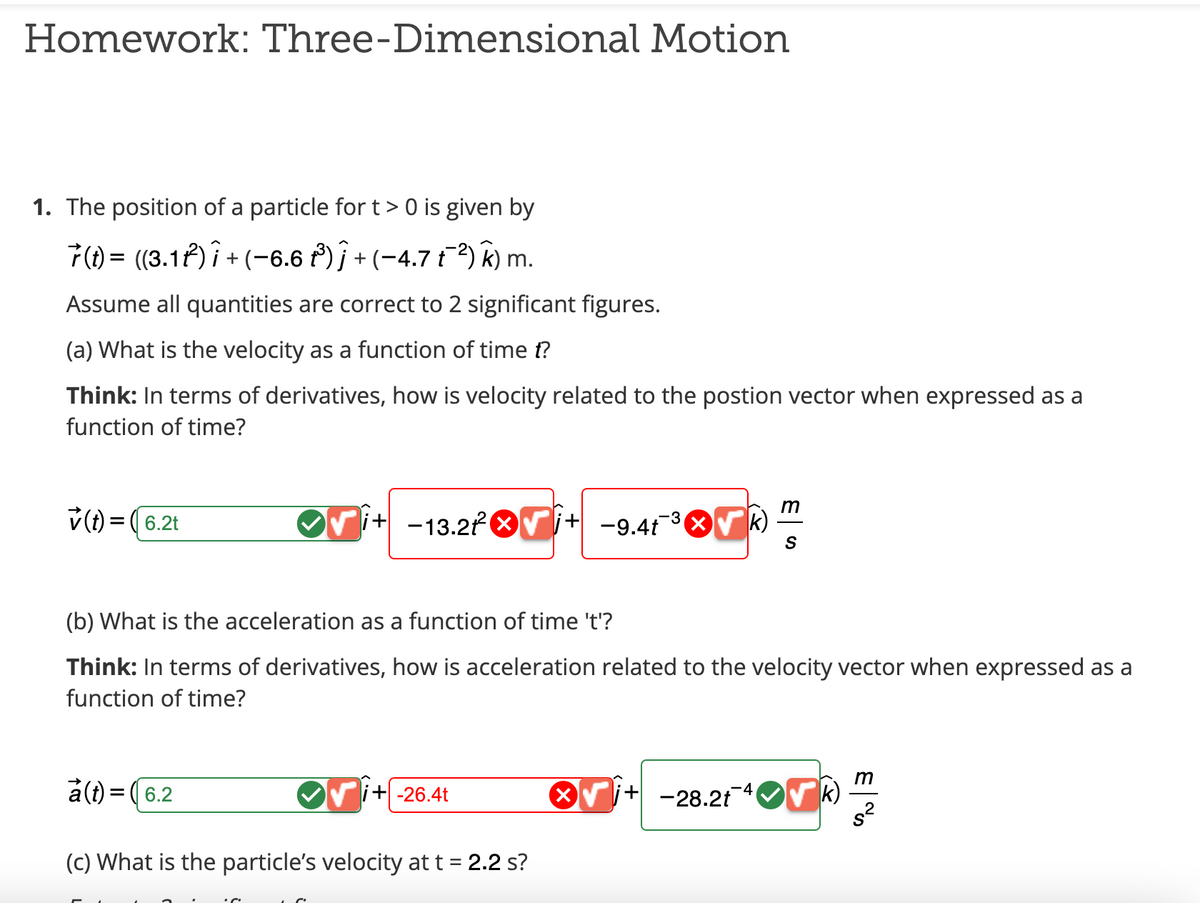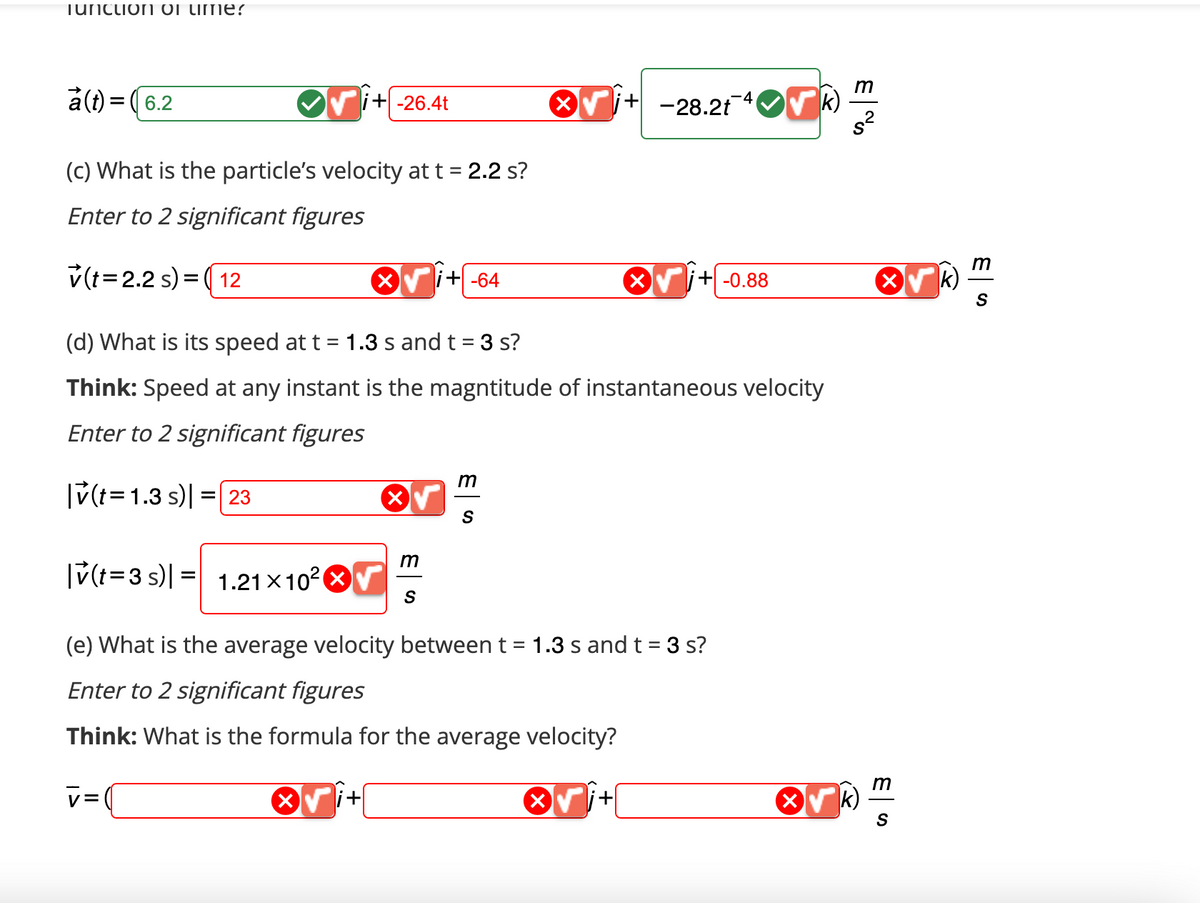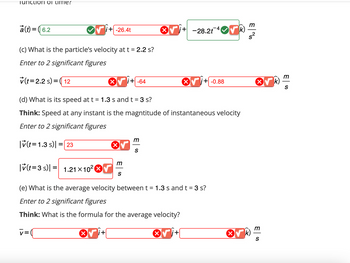1. The position of a particle for t> 0 is given by 7 (t) = ((3.1ť²) Î + (−6.6 t³) ĵ + (−4.7 t¯²) k) m. Assume all quantities are correct to 2 significant figures. (a) What is the velocity as a function of time t? Think: In terms of derivatives, how is velocity related to the postion vector when expressed as a function of time? v(t)=(6.2t i+ -13.22² a(t) = (6.2 +-26.4t j+ -9.4t (b) What is the acceleration as a function of time 't'? Think: In terms of derivatives, how is acceleration related to the velocity vector when expressed as a function of time? (c) What is the particle's velocity at t = 2.2 s? m + -28.2t S m
1. The position of a particle for t> 0 is given by 7 (t) = ((3.1ť²) Î + (−6.6 t³) ĵ + (−4.7 t¯²) k) m. Assume all quantities are correct to 2 significant figures. (a) What is the velocity as a function of time t? Think: In terms of derivatives, how is velocity related to the postion vector when expressed as a function of time? v(t)=(6.2t i+ -13.22² a(t) = (6.2 +-26.4t j+ -9.4t (b) What is the acceleration as a function of time 't'? Think: In terms of derivatives, how is acceleration related to the velocity vector when expressed as a function of time? (c) What is the particle's velocity at t = 2.2 s? m + -28.2t S m
Physics for Scientists and Engineers, Technology Update (No access codes included)
9th Edition
ISBN:9781305116399
Author:Raymond A. Serway, John W. Jewett
Publisher:Raymond A. Serway, John W. Jewett
Chapter3: Vectors
Section: Chapter Questions
Problem 3.62AP: After a ball rolls off the edge of a horizontal table at time t = 0, its velocity as a function of...
Related questions
Concept explainers
Topic Video
Question
3-D Motion in relation to 2D/3D

Transcribed Image Text:Homework: Three-Dimensional Motion
1. The position of a particle for t> 0 is given by
7(t) = ((3.1t²) Î + (−6.6 t³) ĵ + (−4.7 t¯²) k) m.
Assume all quantities are correct to 2 significant figures.
(a) What is the velocity as a function of time t?
Think: In terms of derivatives, how is velocity related to the postion vector when expressed as a
function of time?
✓(t) = (6.2t
m
i+ -13.2² √√i+ −9.4t¯³√k) S
(b) What is the acceleration as a function of time 't'?
Think: In terms of derivatives, how is acceleration related to the velocity vector when expressed as a
function of time?
a(t) = (6.2
i+-26.4t
(c) What is the particle's velocity at t = 2.2 s?
√j+-28.2t¯¯ √k)
m
s²

Transcribed Image Text:Tunction of Lime?
a(t) = (6.2
(c) What is the particle's velocity at t = 2.2 s?
Enter to 2 significant figures
v(t 2.2 s) (12
=
|v(t=3 s) = 1.21x10²
i+-26.4t
v=(
(d) What is its speed at t = 1.3 s and t = 3 s?
Think: Speed at any instant is the magntitude of instantaneous velocity
Enter to 2 significant figures
|v(t=1.3 s) = 23
i+
m
+-64
S
m
S
+-28.2t ✔k)
(e) What is the average velocity between t = 1.3 s and t = 3 s?
Enter to 2 significant figures
Think: What is the formula for the average velocity?
X +-0.88
X
m
s²
X
m
S
m
S
Expert Solution
This question has been solved!
Explore an expertly crafted, step-by-step solution for a thorough understanding of key concepts.
This is a popular solution!
Trending now
This is a popular solution!
Step by step
Solved in 4 steps with 4 images

Follow-up Questions
Read through expert solutions to related follow-up questions below.
Follow-up Question
If you can answer the second part I'd be greatful. Thank you.

Transcribed Image Text:Tunction of Lime?
a(t) = (6.2
(c) What is the particle's velocity at t = 2.2 s?
Enter to 2 significant figures
v(t 2.2 s) (12
=
|v(t=3 s) = 1.21x10²
i+-26.4t
v=(
(d) What is its speed at t = 1.3 s and t = 3 s?
Think: Speed at any instant is the magntitude of instantaneous velocity
Enter to 2 significant figures
|v(t=1.3 s) = 23
i+
m
+-64
S
m
S
+-28.2t ✔k)
(e) What is the average velocity between t = 1.3 s and t = 3 s?
Enter to 2 significant figures
Think: What is the formula for the average velocity?
X +-0.88
X
m
s²
X
m
S
m
S
Solution
Knowledge Booster
Learn more about
Need a deep-dive on the concept behind this application? Look no further. Learn more about this topic, physics and related others by exploring similar questions and additional content below.Recommended textbooks for you

Physics for Scientists and Engineers, Technology …
Physics
ISBN:
9781305116399
Author:
Raymond A. Serway, John W. Jewett
Publisher:
Cengage Learning

Principles of Physics: A Calculus-Based Text
Physics
ISBN:
9781133104261
Author:
Raymond A. Serway, John W. Jewett
Publisher:
Cengage Learning

Physics for Scientists and Engineers, Technology …
Physics
ISBN:
9781305116399
Author:
Raymond A. Serway, John W. Jewett
Publisher:
Cengage Learning

Principles of Physics: A Calculus-Based Text
Physics
ISBN:
9781133104261
Author:
Raymond A. Serway, John W. Jewett
Publisher:
Cengage Learning